Abstract
1. Reflex activity in human arm muscles has been measured in response to torque perturbations around the elbow joint in the flexion-extension direction and/or the supination-pronation direction. Intramuscular fine-wire electrodes were used to record electromyographic (EMG) activity in the muscles. A pre-load was applied in the same direction as or in a different direction to the perturbation. The subjects were instructed to 'hold on', which means that they had to actively resist the perturbation without unduly co-activating their muscles. 2. The EMG activity showed segmented reflex responses with short-latency (25-50 ms) and long-latency (50-75 ms) components, followed by other bursts of activity which probably originated from the subject's voluntary or triggered reactions. 3. Motor units in m. triceps gave short-latency and long-latency responses to imposed elbow extension but only long-latency responses were seen to imposed pronation, which does not stretch m. triceps. Motor units in m. brachialis gave short-latency and long-latency excitatory (inhibitory) responses to imposed extension (flexion) torques. However, only long-latency inhibitory responses were observed to imposed pronation torques. Motor units in m. biceps gave short-latency and long-latency excitatory responses to imposed pronation torques. 4. These results show that the long-latency reflex cannot be the result of a simple feed-back mechanism that controls muscle length only. We argue that the long-latency reflex activity reflects the co-ordinated activation of muscles which is necessary for an adequate response. This hypothesis is supported by the fact that the distribution of long-latency reflex activity over muscles was found to be similar to the distribution of activation found during a voluntary exerted torque in the direction opposite to the applied perturbation.
Full text
PDF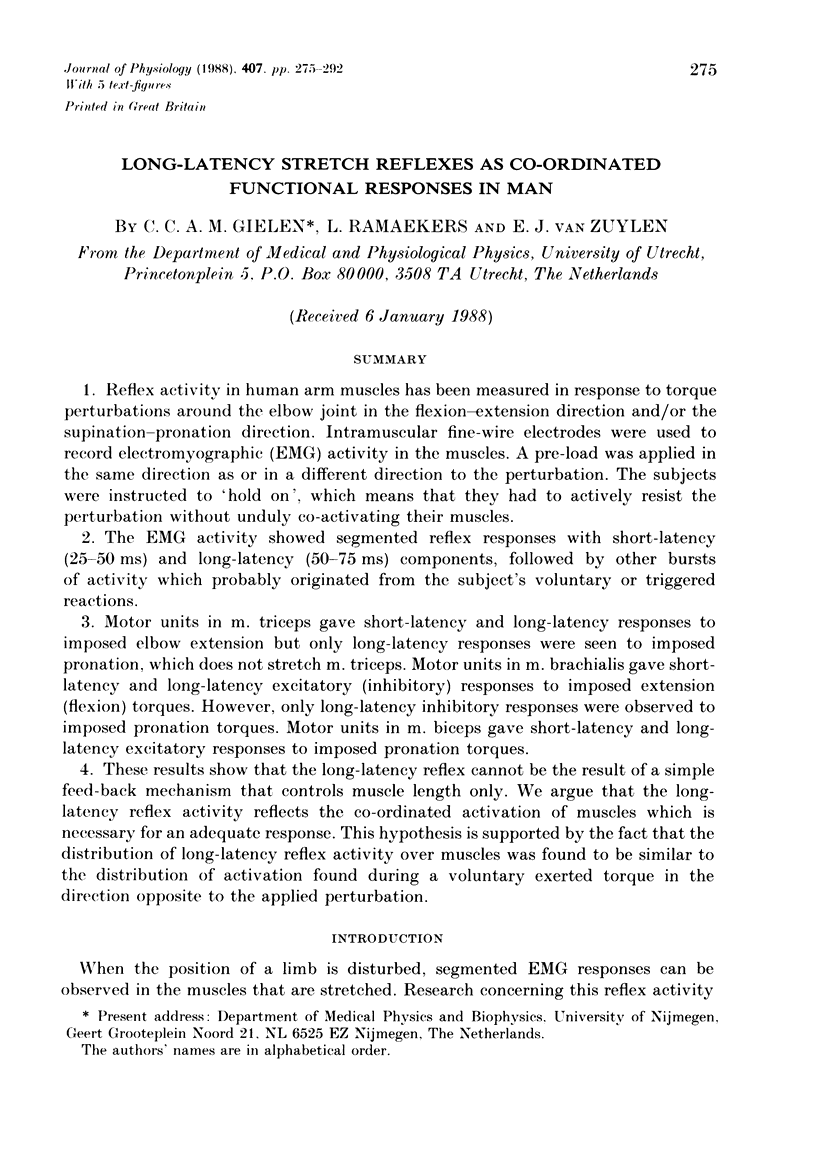
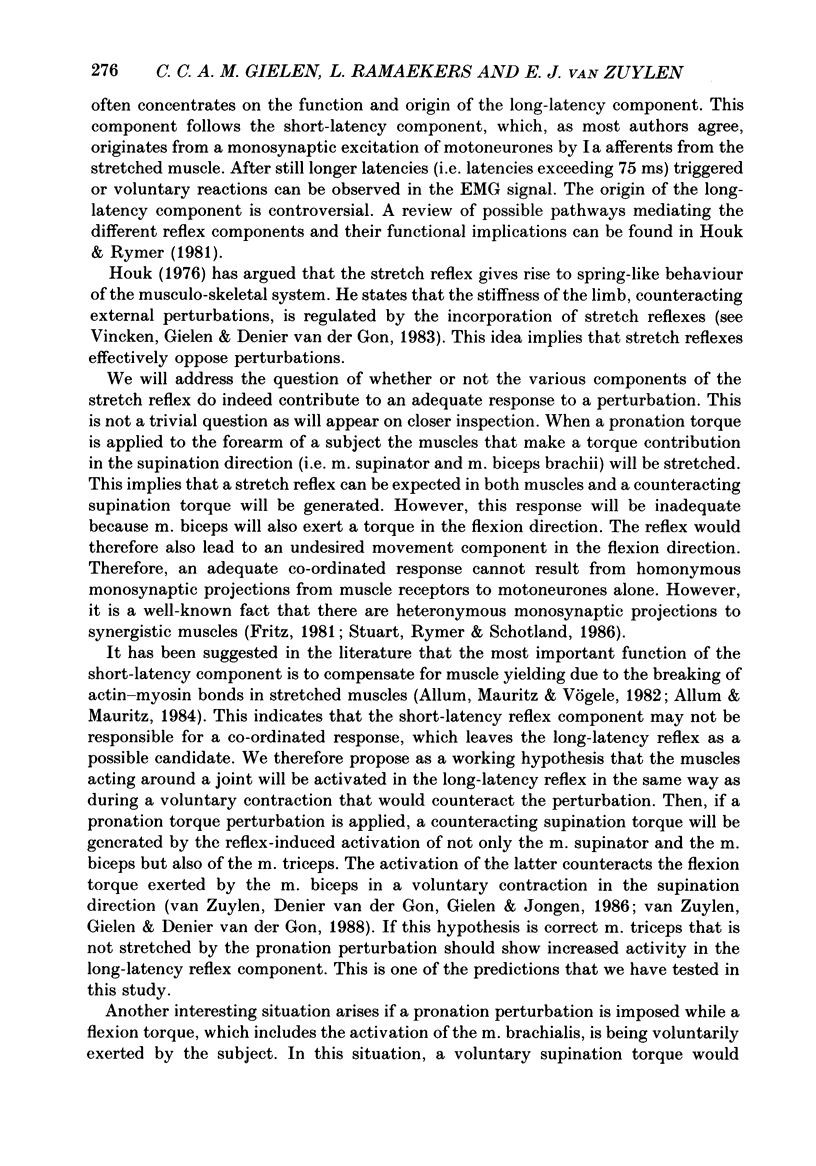
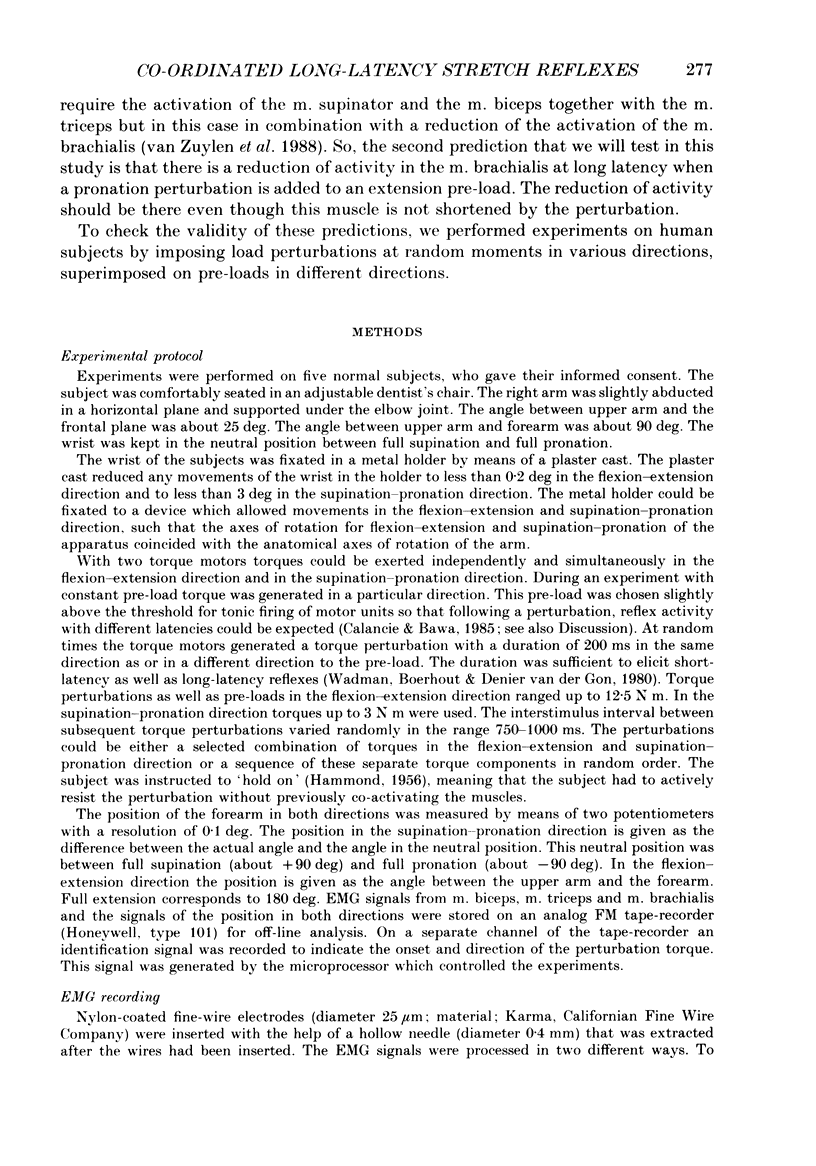
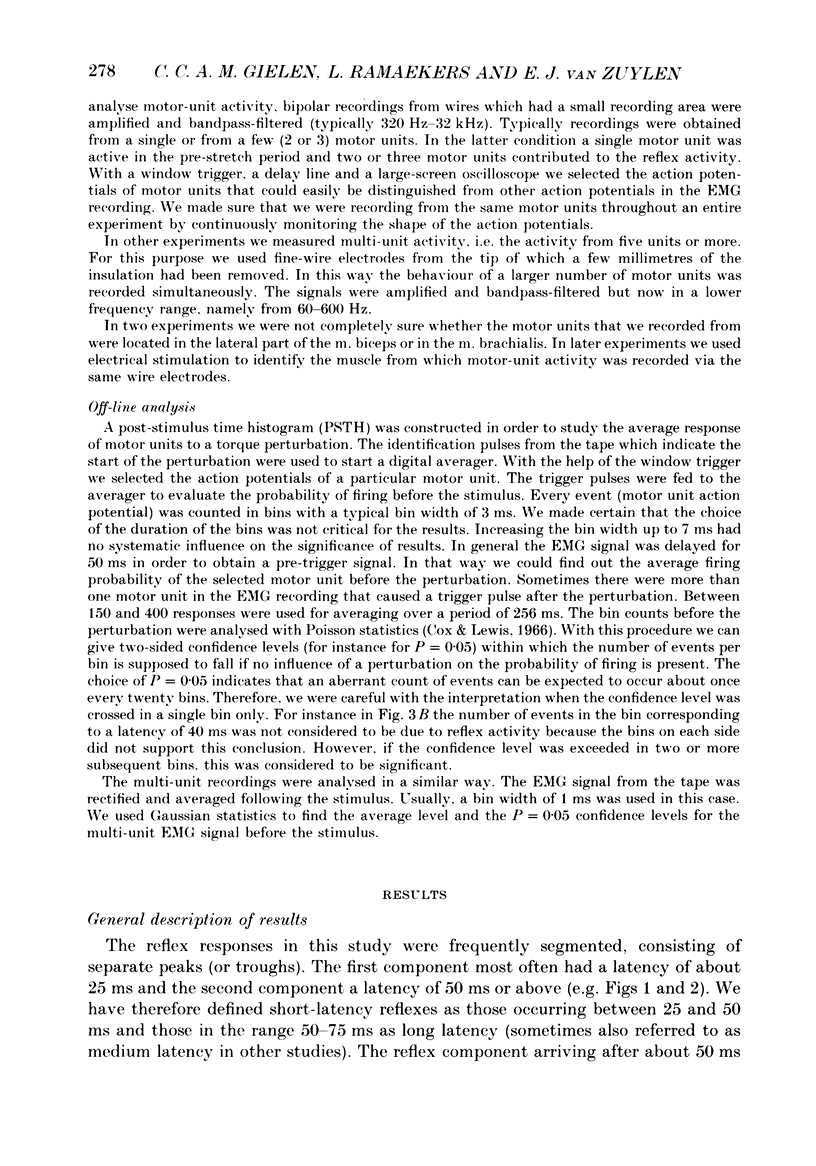


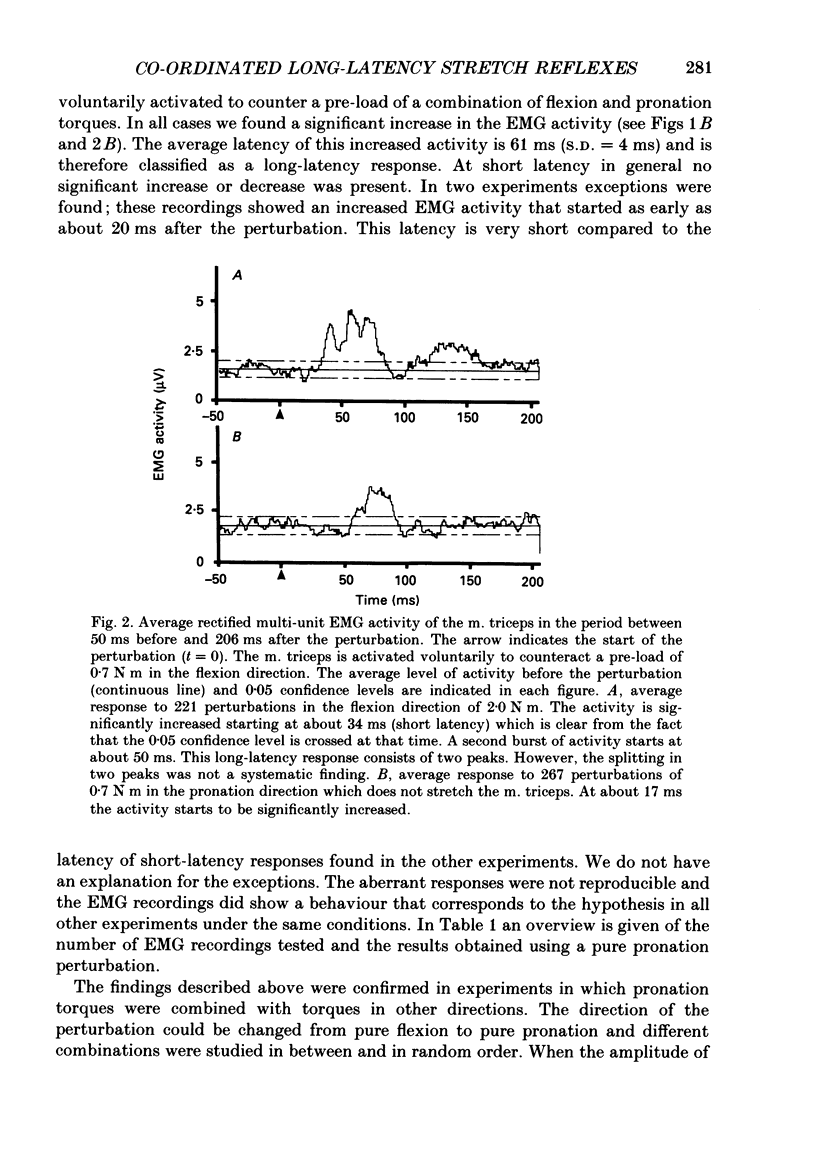
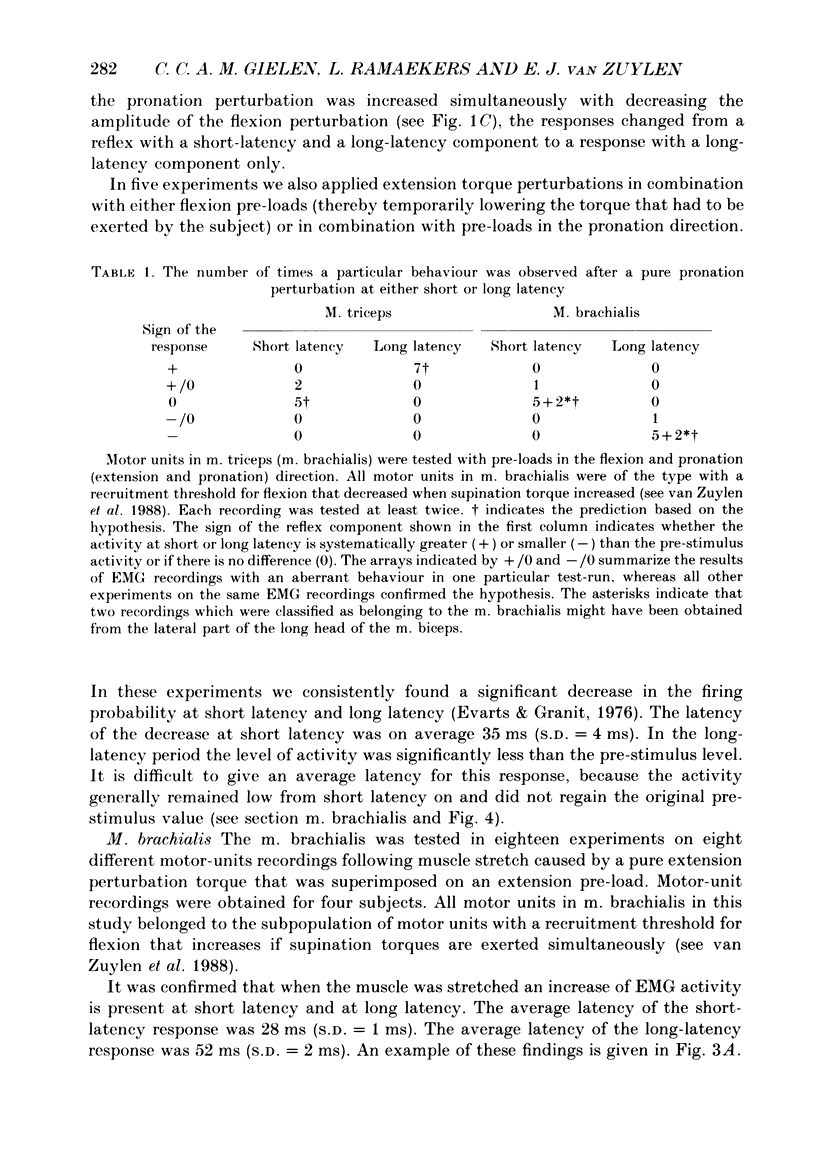
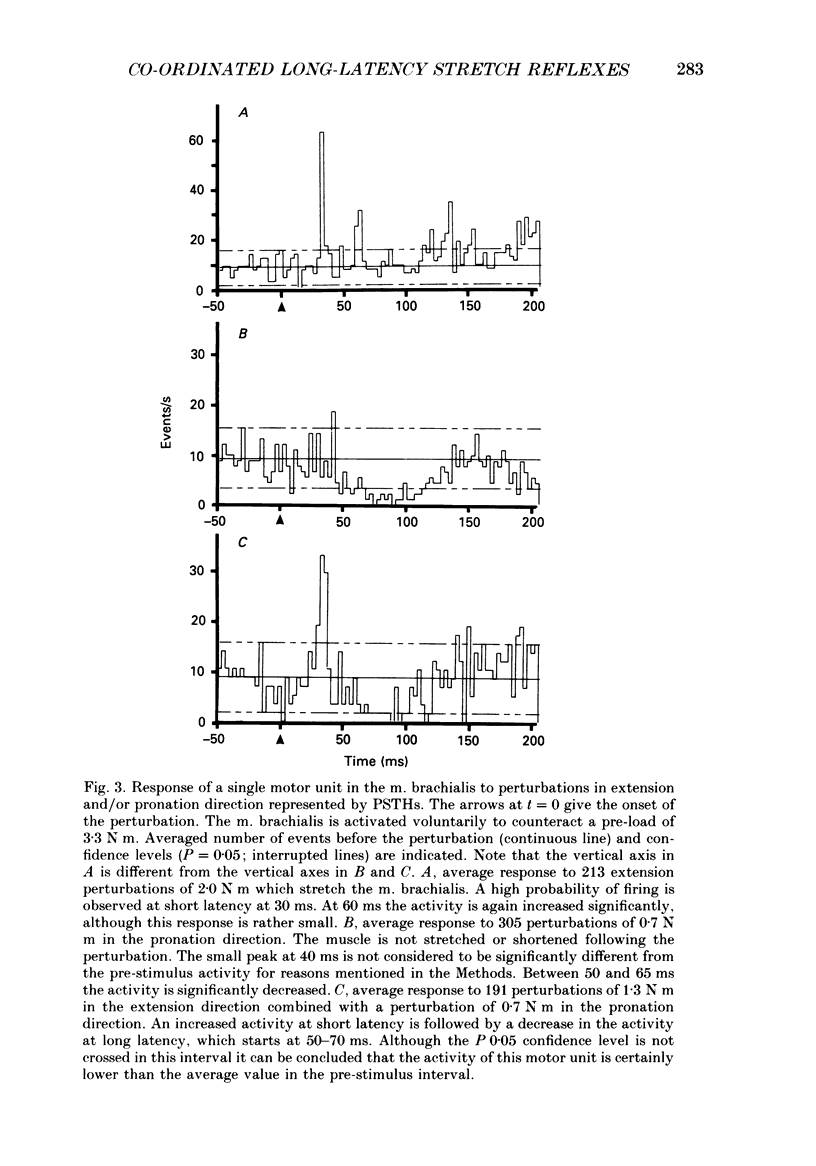


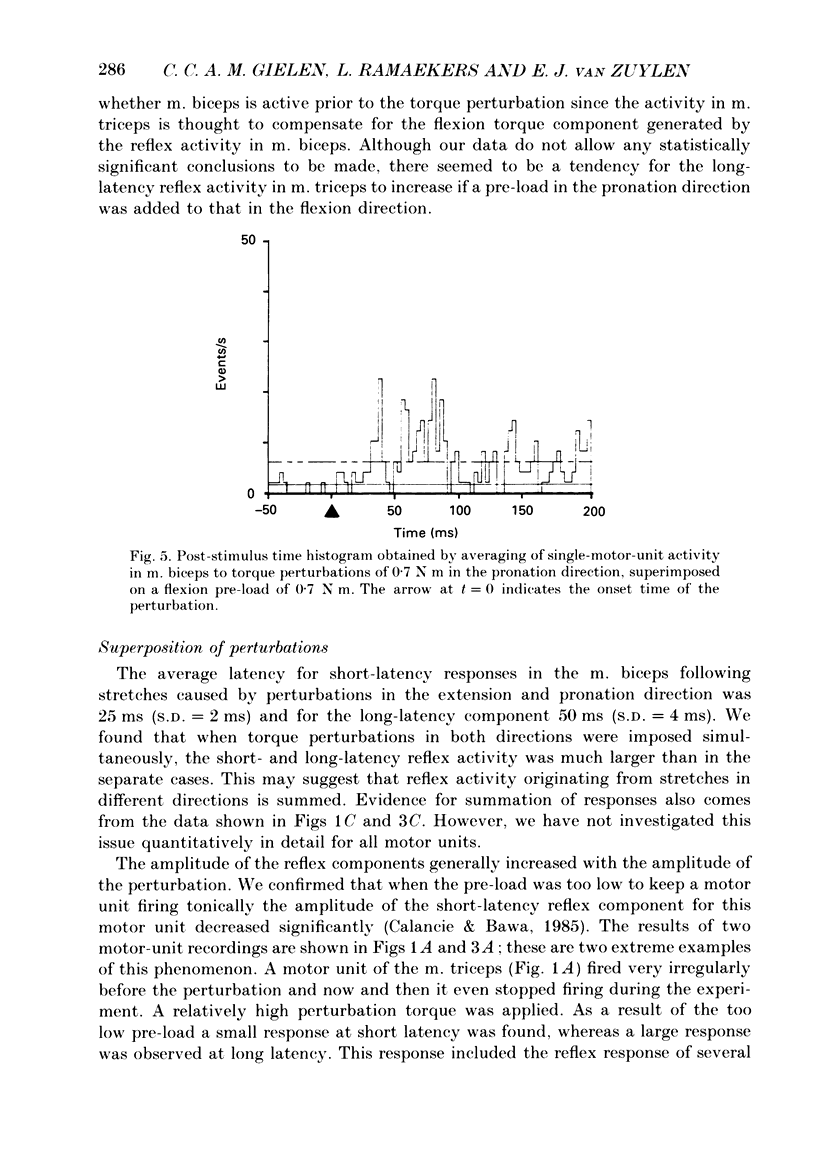



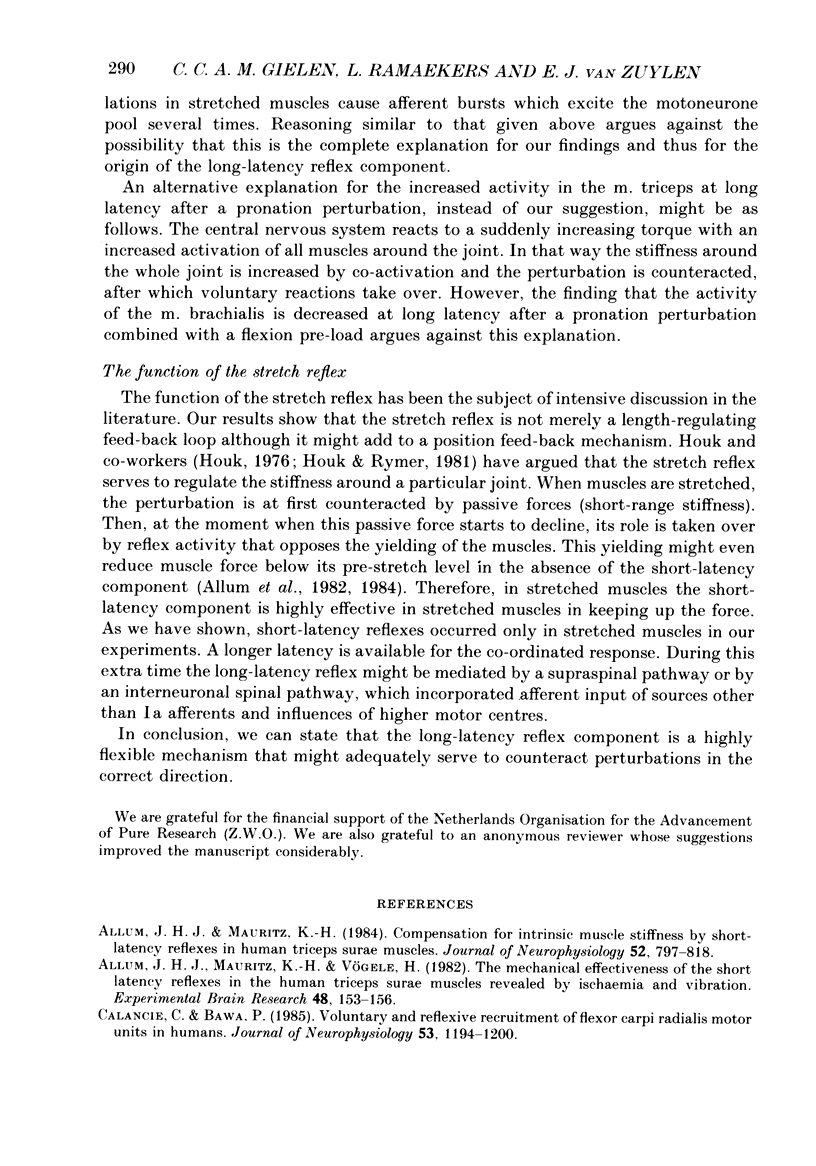
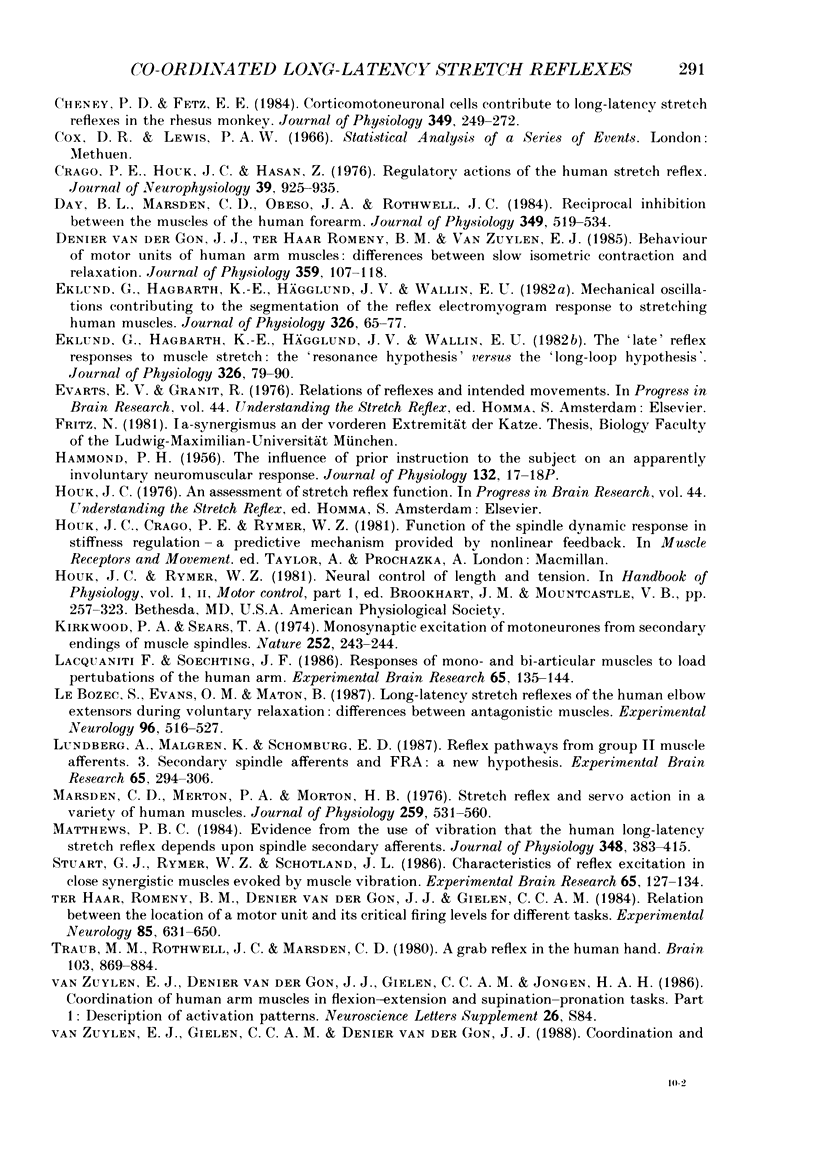
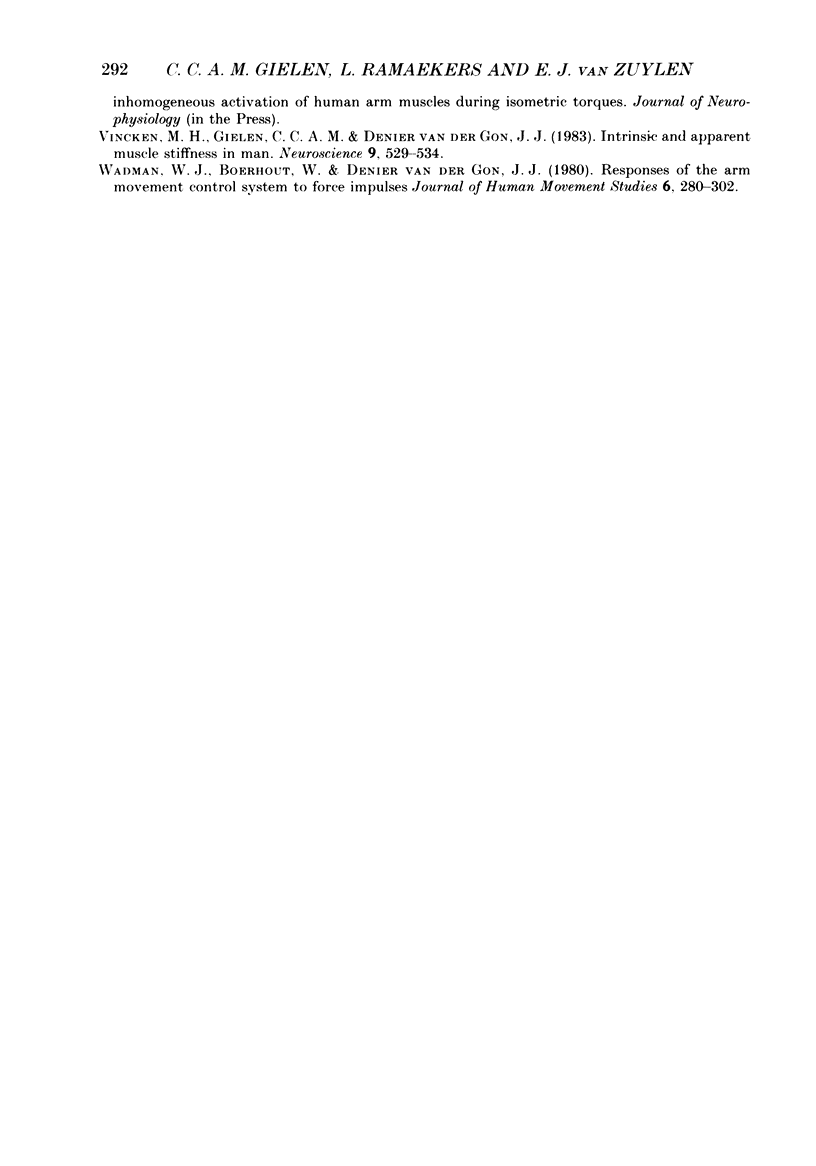
Selected References
These references are in PubMed. This may not be the complete list of references from this article.
- Allum J. H., Mauritz K. H. Compensation for intrinsic muscle stiffness by short-latency reflexes in human triceps surae muscles. J Neurophysiol. 1984 Nov;52(5):797–818. doi: 10.1152/jn.1984.52.5.797. [DOI] [PubMed] [Google Scholar]
- Allum J. H., Mauritz K. H., Vögele H. The mechanical effectiveness of short latency reflexes in human triceps surae muscles revealed by ischaemia and vibration. Exp Brain Res. 1982;48(1):153–156. doi: 10.1007/BF00239584. [DOI] [PubMed] [Google Scholar]
- Calancie B., Bawa P. Voluntary and reflexive recruitment of flexor carpi radialis motor units in humans. J Neurophysiol. 1985 May;53(5):1194–1200. doi: 10.1152/jn.1985.53.5.1194. [DOI] [PubMed] [Google Scholar]
- Cheney P. D., Fetz E. E. Corticomotoneuronal cells contribute to long-latency stretch reflexes in the rhesus monkey. J Physiol. 1984 Apr;349:249–272. doi: 10.1113/jphysiol.1984.sp015155. [DOI] [PMC free article] [PubMed] [Google Scholar]
- Crago P. E., Houk J. C., Hasan Z. Regulatory actions of human stretch reflex. J Neurophysiol. 1976 Sep;39(5):925–935. doi: 10.1152/jn.1976.39.5.925. [DOI] [PubMed] [Google Scholar]
- Day B. L., Marsden C. D., Obeso J. A., Rothwell J. C. Reciprocal inhibition between the muscles of the human forearm. J Physiol. 1984 Apr;349:519–534. doi: 10.1113/jphysiol.1984.sp015171. [DOI] [PMC free article] [PubMed] [Google Scholar]
- Denier van der Gon J. J., ter Haar Romeny B. M., van Zuylen E. J. Behaviour of motor units of human arm muscles: differences between slow isometric contraction and relaxation. J Physiol. 1985 Feb;359:107–118. doi: 10.1113/jphysiol.1985.sp015577. [DOI] [PMC free article] [PubMed] [Google Scholar]
- Eklund G., Hagbarth K. E., Hägglund J. V., Wallin E. U. Mechanical oscillations contributing to the segmentation of the reflex electromyogram response to stretching human muscles. J Physiol. 1982 May;326:65–77. doi: 10.1113/jphysiol.1982.sp014177. [DOI] [PMC free article] [PubMed] [Google Scholar]
- Eklund G., Hagbarth K. E., Hägglund J. V., Wallin E. U. The 'late' reflex responses to muscle stretch: the 'resonance hypothesis' versus the 'long-loop hypothesis'. J Physiol. 1982 May;326:79–90. doi: 10.1113/jphysiol.1982.sp014178. [DOI] [PMC free article] [PubMed] [Google Scholar]
- HAMMOND P. H. The influence of prior instruction to the subject on an apparently involuntary neuro-muscular response. J Physiol. 1956 Apr 27;132(1):17–8P. [PubMed] [Google Scholar]
- Kirkwood P. A., Sears T. A. Monosynaptic excitation of motoneurones from secondary endings of muscle spindles. Nature. 1974 Nov 15;252(5480):243–244. doi: 10.1038/252243a0. [DOI] [PubMed] [Google Scholar]
- Lacquaniti F., Soechting J. F. Responses of mono- and bi-articular muscles to load perturbations of the human arm. Exp Brain Res. 1986;65(1):135–144. doi: 10.1007/BF00243836. [DOI] [PubMed] [Google Scholar]
- Le Bozec S., Evans O. M., Maton B. Long-latency stretch reflexes of the human elbow extensors during voluntary relaxation: differences between agonistic muscles. Exp Neurol. 1987 Jun;96(3):516–527. doi: 10.1016/0014-4886(87)90215-9. [DOI] [PubMed] [Google Scholar]
- Lundberg A., Malmgren K., Schomburg E. D. Reflex pathways from group II muscle afferents. 3. Secondary spindle afferents and the FRA: a new hypothesis. Exp Brain Res. 1987;65(2):294–306. doi: 10.1007/BF00236301. [DOI] [PubMed] [Google Scholar]
- Marsden C. D., Merton P. A., Morton H. B. Stretch reflex and servo action in a variety of human muscles. J Physiol. 1976 Jul;259(2):531–560. doi: 10.1113/jphysiol.1976.sp011481. [DOI] [PMC free article] [PubMed] [Google Scholar]
- Matthews P. B. Evidence from the use of vibration that the human long-latency stretch reflex depends upon spindle secondary afferents. J Physiol. 1984 Mar;348:383–415. doi: 10.1113/jphysiol.1984.sp015116. [DOI] [PMC free article] [PubMed] [Google Scholar]
- Stuart G. J., Rymer W. Z., Schotland J. L. Characteristics of reflex excitation in close synergist muscles evoked by muscle vibration. Exp Brain Res. 1986;65(1):127–134. doi: 10.1007/BF00243835. [DOI] [PubMed] [Google Scholar]
- Traub M. M., Rothwell J. C., Marsden C. D. A grab reflex in the human hand. Brain. 1980 Dec;103(4):869–884. doi: 10.1093/brain/103.4.869. [DOI] [PubMed] [Google Scholar]
- Vincken M. H., Gielen C. C., Denier van der Gon J. J. Intrinsic and afferent components in apparent muscle stiffness in man. Neuroscience. 1983 Jul;9(3):529–534. doi: 10.1016/0306-4522(83)90171-9. [DOI] [PubMed] [Google Scholar]
- ter Haar Romeny B. M., van der Gon J. J., Gielen C. C. Relation between location of a motor unit in the human biceps brachii and its critical firing levels for different tasks. Exp Neurol. 1984 Sep;85(3):631–650. doi: 10.1016/0014-4886(84)90036-0. [DOI] [PubMed] [Google Scholar]


